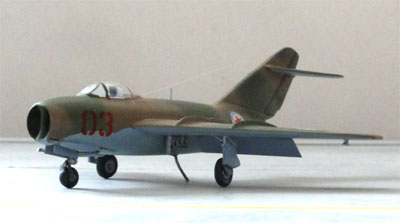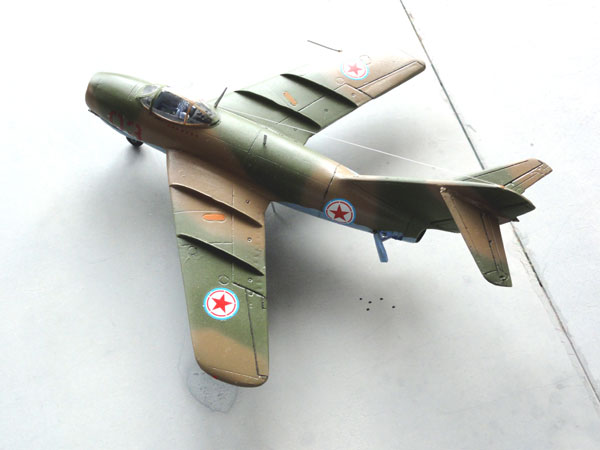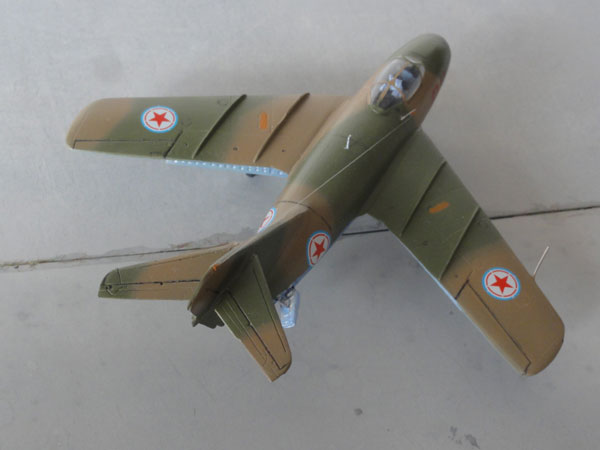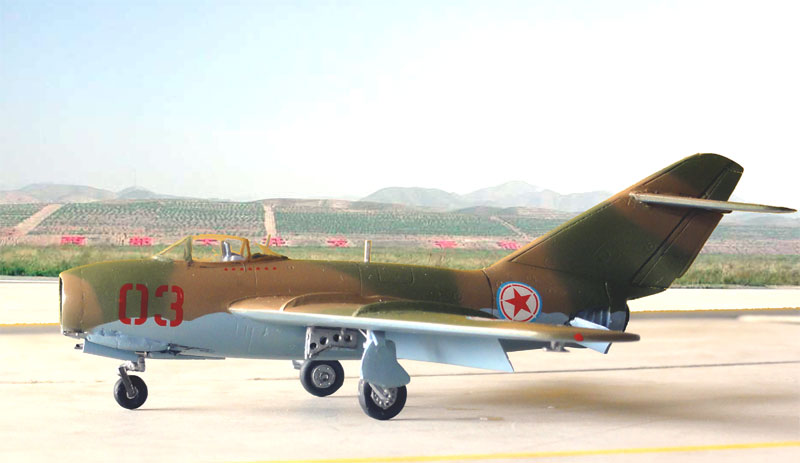[ page 1 ]
1/72 scale kits of the MiG-15 (NATO "fagot")
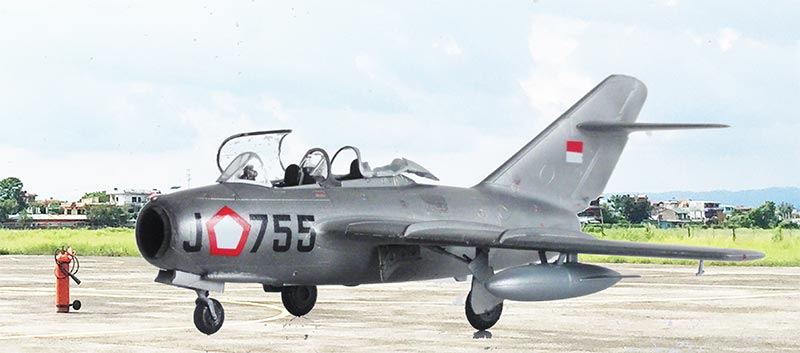
The MiG-15 fighter was designed after the Second World War by the Soviet design bureau Mikoyan-Gurevich OKB. It was the first successful jet fighter of the Soviets with a swept wing using German wing research neat little layout and a Klimov RD-5 engine, based on a "bought and copied" English Rolls Royce Nene jet engine that was allowed by the British Government September 1946. The Mikoyan-Gurevich bureau quickly carried on with several preliminary designs assisted by the TsAGI aerodynamics team of a fighter with a swept wing.
The "S" design eventually became the MiG-15. (The competitive design of Yakovlev with the "Yak-30" was dropped end 1949 though the Lavochkin bureau with its "174D"/ LA-15 would also be produced).
The MiG-15 was first flown end 1947, it soon was used in the Korean War against Western armed forces, fighting against also American F-86 Sabres. The jet air combat was born in which the MiG-15 got NATO code name "Fagot" proved to be very manoevrable with a great rate of climb. It was thus also used by Korea War.
During the Cold War the Western intelligence services did various attempt to acquire the "secret MiG-15".
Look at my info page here for various old articles about defectors, awards and so on.....
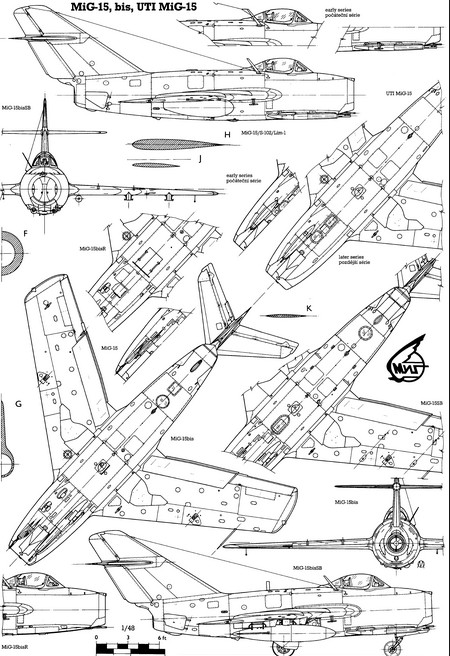
The basic MiG-15 "NATO CODE NAME: Fagot-A" could fly about 1,042 km/hr and for better range had jettisonable underwing fuel tanks. Armament were two 23 mm canons of port and a single 37 mm canon on starboard side with a great punch. The canons were fitted in a lower pack inside the lower fuselage nose. The landing light was in the air intake separator. The radio antenna is a flat plate on top of the fuselage spine.
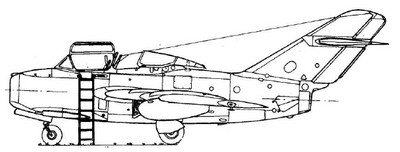
A two seater
trainer was the MiG-15 UTI ("Uchebno Trenirovochnyy istrebitel" -
training fighter), easily recognizable with its large double seat
glazing. The prototype "ST-3" was ready late 1948. It had the same
length as the basic MiG-15 airframe. NATO codename was
"Midget". The cockpit hood has 3 main sections and the rear part slides
to the rear. It would become the main jet trainer in the USSR and many
other countries flying Soviet jets and license made in China as
JJ-5.
![]()
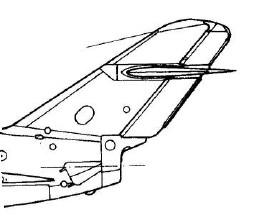
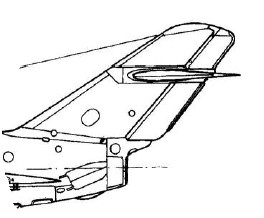
MiG-15 older style tail ; MiG-15bis tail
The MiG-15bis (SB) was a ground attack version could also carry 4 pylons for rockets or bombs.
The USA wanted to investigate the MiG-15 in detail and did everything to obtain an intact MiG. It was amidst the Cold War. A Polish pilot defected in a MiG-15 on the morning of 5 March 1953 to Bornholm. It was a big secret and allowed Western air experts to examine the aircraft for the first time. Soon, other pilots flying MiGs defected regularly from North Korea and China as the pilots were often rewarded by receiving money in "pure gold".
Over 12,000 MiG-15 aircraft were manufactured, also in license in Czechoslovakia (as S-102 and S-103) and Poland (as the Lim-1 and Lim-2, and two-seat SB Lim-1 and SB Lim-2). In China as the single seat J-2. Dozens of Air Forces over the World used the MiG-15.
See further
references.....
....

Many many plastic model kits in 1/72 scale were issued during the years of the MiG-15. Very old but inaccurate kits were from Airfix and old Hasegawa. The shape and looks were completely wrong, for example the old Airfix kit was too large and had a much too large intake.
The best old 1/72 kits were from KP from than Czecho-Slowakia.
In more recent years, again kits appeared. The new Airfix kit is unfortunately again inaccurate and has wrong looks. GRAN came with a kit but this was rudimentary. Hobbyboss of China than came with very good and cheap kits which are worthwhile. More recent, EDUARD came with a series of very nice MiG-15 kits which are very good and detailed. But they are a bit expensive when bought as full special edition.
Most of these 1/72 kits will be made
as models in various schemes and for various Air Forces. For 1/32 scale,
please see the model report here.....

These kits remained in the stack as far better and good kits appeared many years later, particularly of HobbyBoss which are great value for money.
An unknown 1/72 MiG-15bis kit as issued by GRAN from Russia. The box art and decals seemed great so in was bought at a Prague model show in 2005. The kit does seem to be their own mould.
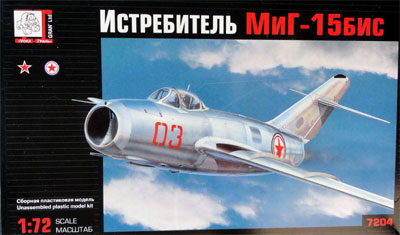

The GRAN decals are nice (printed
by BEGEMOT) for no less than 6 metallic MiG-15's with several "buzz" numbers
from North Korea, two camouflaged North Korean MiGs and a camouflaged Soviet
VVS aircraft.
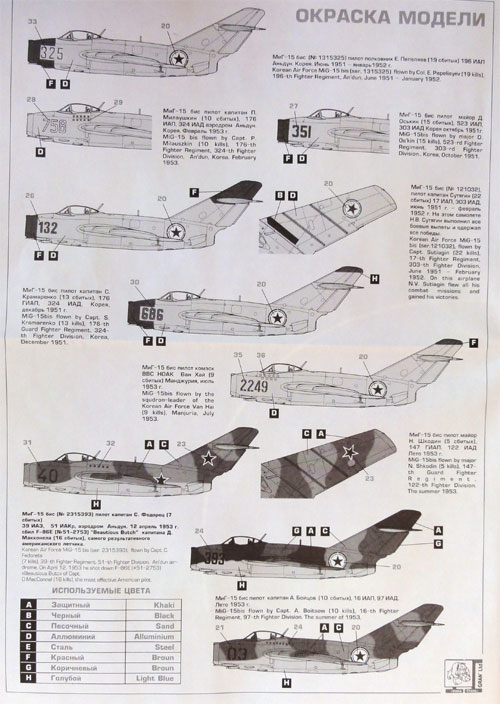
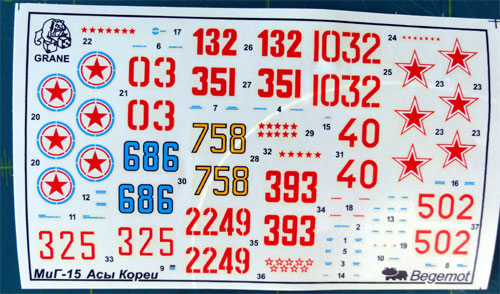
There are about 50 parts in light white cream plastic and the kit instructions suggest it to be a MiG-15 bis with the bigger rear air brakes looking appropriate for a bis and landing light in the lower left wing. A nice feature of the kit are separate parts for flaps that can be drooped down.
The landing gear is very rudimentary: the main doors 38 and 39 should be mounted reversed and the nose wheel leg has no fork. But is has the lower flaps as seperate parts and panels are inscribed. The canopy has a lot of scratches.
The fit is pretty bad and a lot of sanding and filling was needed. The tail exhaust pipe does not fit inside.
This kit is not recommended but at
the time it looked promising. It was made nevertheless in a scheme for
a North Korean MiG-15bis.


The drooped flaps is a nice option
with this kit.
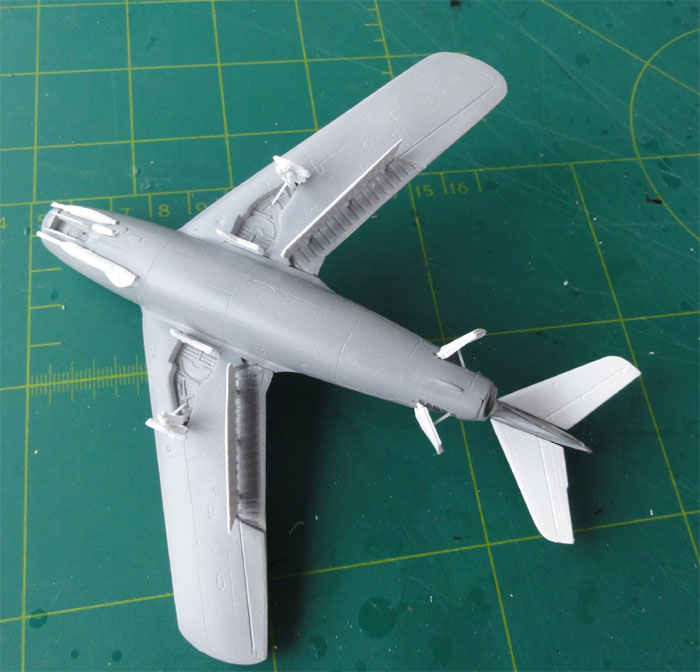
Camouflage colours for the North
Korean MiG-15 used were from Gunze Sangyo acrylics #303 khaki, #310 sand
and lower blue with mixed paints.
Before the decals were applied, a
gloss coat of Johnson Future/Pledge
was applied to prevent decal "silvering".

Undercarriage was refined and
an
antenne wire and other antenna's added and finally the canopy set. Gaps
around were closed with white glue and painted when dried. The small
radio blade antenna on the fuselage for the "bis" was also set in place.
That completed this North Korean MiG-15bis "FAGOT-B" and is a nice model in the World Air Force collection. The nose weight was to low, so to prevent "tail sitting", a metal wire was set below the aft fuselage.
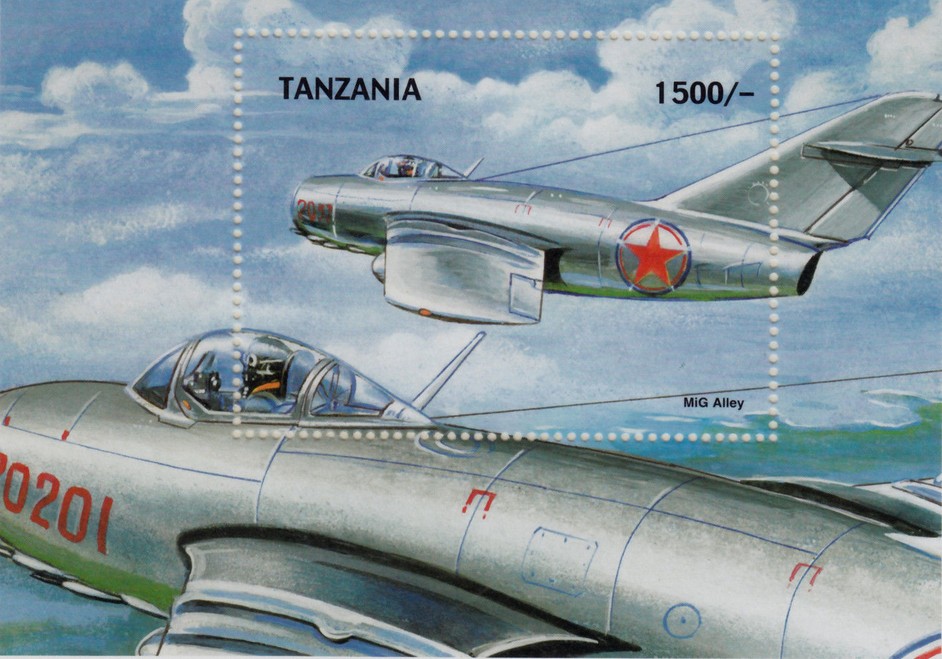
An old postage
stamp of Tanzania shows a North Korean MiG-15
The Peoples Democratic Republic of Korea ("North Korea") was established after decades of occupation by Japan and at the end of the Second World War as Korea was divided in 2 zones: north occupied by the Soviet Union and south occupied by the USA. Two countries were formed. An invasion in June 1950 led to the dramatic Korean War with West and Russian and Chinese involvement. The war ended in July 1953 though no peace treaty was signed. Still as of today, there is a sort of "cease fire". The PDRK is ruled for decades by the Kim Young family.
The Soviet Union delivered from 1948 to the army air force some 80 Yakovlev Yak-9 fighters with local Soviet units also flying the LA-9 and LA-11 and IL-10 bombers. From 1951 quickly hundreds of MiG-15 jets were delivered and Il-28 bombers. The MiG-15 Fagot-A and MiG-15bis Fagot-B were largely flown by Soviet pilots at the units 64 IAK and JAA. The MiG-15bis remained in the 1950s the most important type but was gradually supplemented by MiG-17 and MiG-19. From 1956 MiG-17F and MiG-17PF were delivered although it is unclear if these were Soviet produced aircraft or directly Chinese Shenyang F-5 "copies". Several hundred aircraft were delivered including Chinese license made aircraft that included the Harbin H-5 ("IL-28 copy") in the 1960s that also included MiG-19S with additional Chinese Shenyang F-6. Transports were Ilyushin IL-12 and IL-14 and Antonov An-2 with also helicopters like the Mil Mi-2, Mi-4, Mi-8.
Delivery of the MiG-21 fighter followed but the number is unclear, starting with probably from 1966 some 80 MiG-21 F13 though some reported the first arrived in 1963. It is probable also about 100 MiG-21PFM followed from 1969. In the 1970s and 1980s this fleet was kept operational with much difficulties. China's involvement was also the delivery and support of Shenyang F-5, F-6 and some 40 Nanchang A-5/ Q-5 attack aircraft. The large array of aircraft included also some extra transports like the IL-62, Tu-134 and Tu-154. From 1984 some 50 MiG-23ML and UB followed in additional to the (earlier obtained) 30 SU-7 Fitter and from 1987 approx. 30 SU-25 ground attack aircraft. From 1985 over 40 attack helicopters of the type Mi-24 Hind were obtained.
From 1988 it appears that MiG-29 Fulcrums started to arrive with a local manufacturing/ assembly facility established. It appears some 20 MiG-29 9.12 and some 6 MiG-29 9.13 Fulcrum-C and 4 MiG-29UB trainers were made operational. Some reports say that from Belarus additional MiG-29SE were acquired from 1995. The MiG-29 are mostly based at Sunchon base.Other types in the 1990s were over 120 MiG-21 including some 30 Chengdu F-7 though serviceability and operational capability looks to be limited. It appears a small number of Mil Mi-26 were acquired through Belarus in 2008.
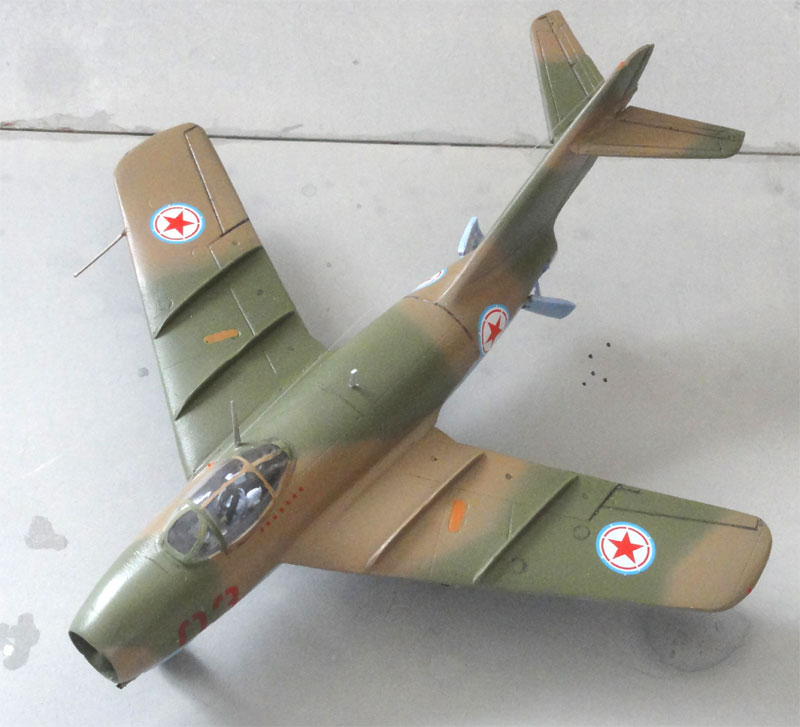
The MiG-15bis, North Korean as flown by Capt. Boitsow with "10 kills" of the 16th fighter regiment, Korea war 1953.
On to next
MiG-15 [ Page 2 ... ]
References:
 ..
..
- Mikoyan Gurevich MiG-15, 4+ publications, Czechia, 1997 (highly recommended)
- MiG-15 in Action, Squadron Signal, USA, 1990 (a bit inaccurate in some areas)
- Wings of Fame series, article, Vol. 08, page 100 etc.
- OKB MiG, Butowski and Miller, Aerofax inc, 1991
- Soviet and Russian Military aircraft series: (1) in Asia, (2) in Africa, (3) in Middle East; by Yefim Gordon and Kommissarov, Hikoki publications
- African Migs, Tom Cooper, Volume 1, Harpia publications, 2010
- African Migs, Tom Cooper, Volume 2, Harpia publications, 2011
- Arab Migs, Tom Cooper, Volume 5, Harpia publications, 2014
Back to 1/72 Models.......
(c) Copyright Meindert "designer"/ All rights reserved. Your comments are welcomed by webmaster
Created this page
September 14, 2015;
update July, 9, 2019
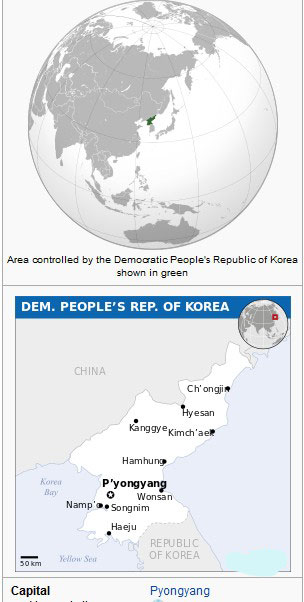
 ....
....
